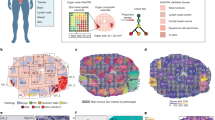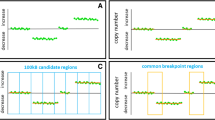Abstract
Sections from archival formalin-fixed, paraffin wax-embedded human tissues are a valuable source for the study of the nuclear architecture of specific tissue types in terms of the three-dimensional spatial positioning and architecture of chromosome territories and sub-chromosomal domains. Chromosome painting, centromeric, and locus-specific probes were hybridized to tissue microarrays prepared from formalin-fixed paraffin wax-embedded samples of pancreas and breast. The cell nuclei were analyzed using quantitative three-dimensional image microscopy. The results obtained from non-neoplastic pancreatic cells of randomly selected individuals indicated that the radial arrangement of the chromosome 8 territories as well as their shape (roundness) did not significantly differ between the individuals and were in accordance with assumptions of a probabilistic model for computer simulations. There were considerable differences between pancreatic tumor and non-neoplastic cells. In non-neoplastic ductal epithelium of the breast there was a larger, but insignificant, variability in the three-dimensional positioning of the centromere 17 and HER2 domains between individuals. In neoplastic epithelial breast cells, however, the distances between centromere and gene domains were, on average, smaller than in non-neoplastic cells. In conclusion, our results demonstrate the feasibility of studying the genome architecture in archival, formalin-fixed, paraffin wax-embedded human tissues, opening new directions in tumor research and cell classification.






Similar content being viewed by others
References
Altmann DG (1991) Practical statistics for medical research. Chapman and Hall, London, pp 194–197
Amrichová J, Lukášová E, Kozubek S, Kozubek M (2003) Nuclear and territorial topography of chromosome telomeres in human lymphocytes. Exp Cell Res 289:11–26
Bártová E, Kozubek S, Jirsová P, Kozubek M, Gajová H, Lukásová E, Skalniková M, Ganová A, Koutná I, Hausmann M (2002) Nuclear topography and gene activity in human differentiated cells. J Struct Biol 139:76–89
Boyle S, Gilchrist S, Bridger JM, Mahy NL, Ellis JA, Bickmore WA (2001) The spatial organization of human chromosomes within the nuclei of normal and emerin-mutant cells. Hum Mol Genet 10:211–219
Bridger JM, Boyle S, Kill IR, Bickmore WA (2000) Re-modelling of nuclear architecture in quiescent and senescent human fibroblasts. Curr Biol 10:149–152
Cremer M, Hase J von, Volm T, Brero A, Kreth G, Walter J, Fischer C, Solovei I, Cremer C, Cremer T (2001) Non-random radial higher-order chromatin arrangements in nuclei of diploid human cells. Chromos Res 9:541–567
Cremer M, Küpper K, Wagler B, Wizelman L, Hase J von, Weiland Y, Kreja L, Diebold J, Speicher MR, Cremer T (2003) Inheritance of gene density-related higher order chromatin arrangements in normal and tumor cell nuclei. J Cell Biol 162:809–820
Cremer T, Cremer C (2001) Chromosome territories, nuclear architecture and gene regulation in mammalian cells. Nat Rev Genet 2:292–301
Cremer T, Kreth G, Koester H, Fink RHA, Heintzmann R, Cremer M, Solovei I, Zink D, Cremer C (2000) Chromosome territories, inter chromatin domain compartment and nuclear matrix: an integrated view on the functional nuclear architecture. Crit Rev Eukaryot Gene Expr 10:179–212
Cremer T, Kupper K, Dietzel S, Fakan S (2004) Higher order chromatin architecture in the cell nucleus: on the way from structure to function. Biol Cell 96:555–567
Croft JA, Bridger JM, Boyle S, Perry P, Teague P, Bickmore WA (1999) Differences in the localization and morphology of chromosomes in the human nucleus. J Cell Biol 145:1119–1131
van Driel R, Fransz PF, Verschure PJ (2003) The eukaryotic genome: a system regulated at different hierarchical levels. J Cell Sci 116:4067–4075
Esa A, Edelmann P, Trakhtenbrot L, Amariglio N, Rechavi G, Hausmann M, Cremer C (2000) 3D-Spectral Precision Distance Microscopy (SPDM) of chromatin nanostructures after triple-colour DNA labelling: a study of the BCR-region on chromosome 22 and the Philadelphia chromosome. J Microsc 199:96–105
Falk M, Lukásová E, Kozubek S, Kozubek M (2002) Topography of genetic elements of X-chromosome relative to the cell nucleus and to the chromosome X territory determined for human lymphocytes. Gene 292:13–24
Gerlich D, Beaudouin J, Kalbfuss B, Daigle N, Eils R, Ellenberg J (2003) Global chromosome positions are transmitted through mitosis in mammalian cells. Cell 112:751–764
Hausmann M, Esa A, Edelmann P, Trakhtenbrot L, Amariglio N, Rechavi G, Cremer C (2000) Einblicke in die dreidimensionale Architektur des Zellkerns. In: Heinemann G, Müller WU (eds) Strahlenbiologie und Strahlenschutz—Individuelle Strahlenempfindlichkeit und ihre Bedeutung für den Strahlenschutz, vol. I. TÜV-Verlag, Cologne, pp 87–104
Hausmann M, Cremer C, Linares-Cruz G, Nebe TC, Peters K, Plesch A, Tham J, Vetter M, Werner M (2004) Standardisation of FISH-procedures: summary of the second discussion workshop. Cell Oncol 26:119–124
Knuth DE (1981) The art of computer programming. Addison, Reading, UK
Kozubek S, Lukášová E, Mareckova A, Skalniková M, Kozubek M, Bartová E, Kroha V, Krahulcová E, Slotová J (1999) The topological organization of chromosomes 9 and 22 in cell nuclei has a determinative role in the induction of t(9,22) translocations and in the pathogenesis of t(9,22) leukemias. Chromosoma 108:426–435
Kozubek S, Lukášová E, Jirsová P, Koutná I, Kozubek M, Ganová A, Bártová E, Falk M, Paseková R (2002) 3D structure of the human genome: order in randomness. Chromosoma 111:321–331
Kreth G, Finsterle J, Hase J von, Cremer M, Cremer C (2004) Radial arrangement of chromosome territories in human cell nuclei: a computer model approach based on gene density indicated a probabilistic global positioning code. Biophys J 86:2803–2812
Lelievre SA, Weaver VM, Nickerson JA, Larabell CA, Bhaumik A, Petersen OW, Bissell MJ (1998) Tissue phenotype depends on reciprocal interactions between the extracellular matrix and the structural organization of the nucleus. Proc Natl Acad Sci U S A 95:14711–14716
Lukášová E, Kozubek S, Kozubek M, Kjeronská J, Rýznar L, Horáková J, Krahulcová E, Horneck G (1999) Localisation and distance between ABL and BCR genes in interphase nuclei of bone marrow cells of control donors and patients with chronic myeloid leukaemia. Hum Genet 100:525–535
Lukášová E, Kozubek S, Kozubek M, Falk M, Amrichová J (2002) The 3D structure of human chromosomes in cell nuclei. Chromos Res 10:535–548
Neves H, Ramos C, da Silva MG, Parreira A, Parreira L (1999) The nuclear topography of ABL, BCR, PML, and RARalpha genes: evidence for gene proximity in specific phases of the cell cycle and stages of hematopoietic differentiation. Blood 93:1197–1207
Nikiforova MN, Stringer JR, Blough R, Medvedovic M, Fagin JA, Nikiforov YE (2000) Proximity of chromosomal loci that participate in radiation-induced rearrangements in human cells. Science 290:138–141
Parada L, Misteli T (2002) Chromosome positioning in the interphase nucleus. Trends Cell Biol 12:425–432
Parada LA, McQueen PG, Munson PJ, Misteli T (2002) Conservation of relative chromosome positioning in normal and cancer cells. Curr Biol 12:1692–1697
Parada LA, McQueen PG, Misteli T (2004a) Tissue specific spatial organization of genomes. Genome Biol 5:R44. Epub 21 Jun 2004
Parada LA, Sotiriou S, Misteli T (2004b) Spatial genome organization. Exp Cell Res 296:64–70
Roix JJ, McQueen PG, Munson PJ, Parada LA, Misteli T (2003) Spatial proximity of translocation-prone gene loci in human lymphomas. Nat Genet 34:287–291
Solovei I, Cavallo A, Schermelleh L, Jaunin F, Scasselati C, Cmarko D, Cremer C, Fakan S, Cremer T (2002) Spatial preservation of nuclear chromatin architecture during three-dimensional fluorescence in situ hybridization (3D-FISH). Exp Cell Res 276:10–23
Spector DL (2003) The dynamics of chromosome organization and gene regulation. Annu Rev Biochem 72:573–608
Stein S, Solovei I, Cremer M, Zinner R, Timme S, Walch A, Werner M, Hausmann M, Cremer C (2004) 3D-image analysis of the topological organisation of chromatin in human lymphocytes, fibroblasts and in cancer cells of formalin-fixed, paraffin-embedded tissue sections. 15th International Chromosome Conference, London, 5–10 September 2004. Chromos Res 12 [Suppl 1]:34
Sun HB, Shen J, Yokota H (2000) Size-dependent positioning of human chromosomes in interphase nuclei. Biophys J 79:184–190
Tanabe H, Habermann FA, Solovei I, Cremer M, Cremer T (2002a) Non-random radial arrangements of interphase chromosome territories: evolutionary considerations and functional implications. Mutat Res 504:37–45
Tanabe H, Muller S, Neusser M, Hase J von, Calcagno E, Cremer M, Solovei I, Cremer C, Cremer T (2002b) Evolutionary conservation of chromosome territory arrangements in cell nuclei from higher primates. Proc Natl Acad Sci U S A 99:4424–4429
Taslerová R, Kozubek S, Lukásová E, Jirsová P, Bártová E, Kozubek M (2003) Arrangement of chromosome 11 and 22 territories, EWSR1 and FLI1 genes, and other genetic elements of these chromosomes in human lymphocytes and Ewing sarcoma cells. Hum Genet 112:143–155
Volpi EV, Chevret E, Jones T, Vatcheva R, Williamson J, Beck S, Campbell RD, Goldworthy M, Powis SH, Ragoussis J, Trowsdale J, Sheer D (2000) Large-scale chromatin organization of the major histocompatibility complex and other regions of human chromosome 6 and its response to interferon in interphase nuclei. J Cell Sci 113:1565–1576
Walch A, Bink K, Hutzler P, Böwering K, Letsiou I, Zitzelsberger H, Braselmann H, Stein H, Höfler H, Werner M (2001) Sequential multilocus fluorescence in situ hybridization can detect complex patterns of increased gene dosage at the single cell level in tissue sections. Lab Invest 81:1457–1459
Walter J, Schermelleh L, Cremer M, Tashiro S, Cremer T (2003) Chromosome order in HeLa cells changes during mitosis and early G1, but is stably maintained during subsequent interphase stages. J Cell Biol 160:685–697
Weierich C, Brero A, Stein S, Hase J von, Cremer C, Cremer T, Solovei I (2003) Three-dimensional arrangements of centromeres and telomeres in nuclei of human and murine lymphocytes. Chromos Res 11:485–502
Zink D, Fischer AH, Nickerson JA (2004) Nuclear structure in cancer cells. Nat Rev Cancer 4:677–687
Acknowledgements
The authors thank L. Bokla, Freiburg, for excellent technical assistance. The authors gratefully acknowledge the financial support of the Deutsche Krebshilfe (AZ: 79–2789-Si 3) and the Bundesminister für Bildung und Forschung (FKZ 13N8350).
Author information
Authors and Affiliations
Corresponding author
Rights and permissions
About this article
Cite this article
Wiech, T., Timme, S., Riede, F. et al. Human archival tissues provide a valuable source for the analysis of spatial genome organization. Histochem Cell Biol 123, 229–238 (2005). https://doi.org/10.1007/s00418-005-0768-3
Accepted:
Published:
Issue Date:
DOI: https://doi.org/10.1007/s00418-005-0768-3




